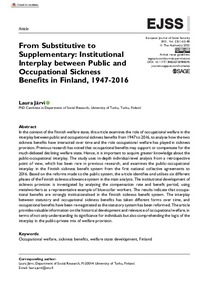From Substitutive to Supplementary: Institutional Interplay between Public and Occupational Sickness Benefits in Finland, 1947-2016
Järvi Laura
From Substitutive to Supplementary: Institutional Interplay between Public and Occupational Sickness Benefits in Finland, 1947-2016
Järvi Laura
SAGE PUBLICATIONS LTD
Julkaisun pysyvä osoite on:
https://urn.fi/URN:NBN:fi-fe2021042823989
https://urn.fi/URN:NBN:fi-fe2021042823989
Tiivistelmä
In the context of the Finnish welfare state, this article examines the role of occupational welfare in the interplay between public and occupational sickness benefits from 1947 to 2016, to analyse how the two sickness benefits have interacted over time and the role occupational welfare has played in sickness provision. Previous research has noted that occupational benefits may support or compensate for the much-debated declining welfare state. Hence, it is important to acquire greater knowledge about the public-occupational interplay. The study uses in-depth individual-level analysis from a retrospective point of view, which has been rare in previous research, and examines the public-occupational interplay in the Finnish sickness benefit system from the first national collective agreements to 2016. Based on the reforms made to the public system, the article identifies and utilises six different phases of the Finnish sickness allowance system in the main analysis. The institutional development of sickness provision is investigated by analysing the compensation rate and benefit period, using metalworkers as a representative example of blue-collar workers. The results indicate that occupational benefits are strongly institutionalised in the Finnish sickness benefit system. The interplay between statutory and occupational sickness benefits has taken different forms over time, and occupational benefits have been re-negotiated as the statutory system has been reformed. The article provides valuable information on the historical development and relevance of occupational welfare, in terms of not only understanding its significance for individuals but also comprehending the logic of the interplay in the public-private mix of welfare provision.
Kokoelmat
- Rinnakkaistallenteet [19250]
